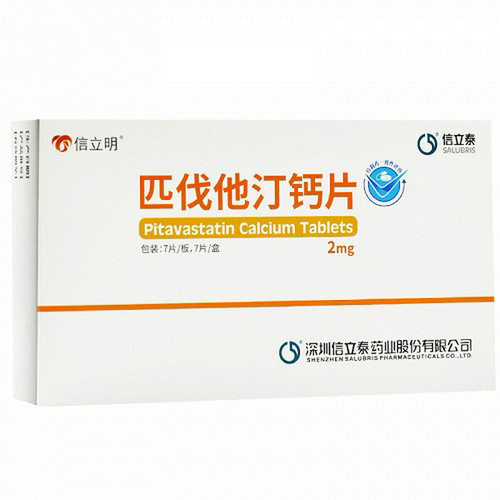Product Overview
[Drug Name]
Generic Name: Pitavastatin Calcium Tablets
Trade Name: Guanshuang Pitavastatin Calcium Tablets, 2mg x 14 tablets
[Main Ingredient]
Pitavastatin calcium.
[Appearance]
Off-white tablets, off-white after removing the coating.
[Indications/Main Functions]
Mainly used for hypercholesterolemia and familial hypercholesterolemia.
[Specifications]
2mg x 14 tablets (Guanshuang)
[Dosage and Administration]
Adults: Take 1-2 mg orally once daily after dinner. Adjust the dose based on age and symptoms. If LDL-C lowering is unsatisfactory, increase the dose to a maximum daily dose of 4 mg.
[Adverse Reactions]
Major adverse reactions include abdominal pain, rash, depression, itching, and elevated levels of R-glutamyl transpeptidase, creatine kinase (CK1), alanine transaminase, and aspartate aminotransferase. Serious adverse reactions include rhabdomyolysis and myopathy.
[Contraindications]
This product is contraindicated in patients with allergies and during pregnancy.
[Drug Interactions]
Drug interactions may occur if used concurrently with other medications. Please consult your physician or pharmacist for details.
[Precautions]
Pitavastatin calcium tablets should be used with caution in patients who consume alcohol excessively or have a history of liver disease. Report any unexplained myalgia or weakness, especially if accompanied by fever, to a physician immediately. These patients should have their CK levels checked. If CK levels are elevated or if myopathy is clinically suspected, this product should be discontinued immediately.
[Pediatric Use]
The safety of this product in children has not been established (based on user experience).
[Elderly Use]
Generally, elderly patients have decreased physiological function, so if adverse reactions occur, the dosage should be reduced. There have been reports that elderly patients are more susceptible to rhabdomyolysis.
[Overdose]
The information is unknown.
[Pharmacology and Toxicology]
Pitavastatin calcium inhibits hepatic cholesterol synthesis by antagonizing HMG-CoA reductase, the rate-limiting enzyme in the cholesterol biosynthesis pathway. It promotes the expression of low-density lipoprotein (LDL) receptors in the liver and the entry of LDL from the blood into the liver, thereby lowering total cholesterol. Furthermore, it continuously inhibits cholesterol biosynthesis in the liver, reduces the secretion of very low-density lipoprotein (VLDL) into the blood, and reduces plasma triglycerides. 1. Inhibition of HMG-CoA Reductase: In vitro studies using rat liver microsomes demonstrated that pitavastatin calcium antagonizes HMG-CoA reductase with an IC50 of 6.8 nM. 2. Inhibition of Cholesterol Synthesis: In vitro studies using the human hepatoma cell line HepG2 demonstrated that pitavastatin calcium inhibited cholesterol synthesis in a concentration-dependent manner. Oral administration studies in rats demonstrated that pitavastatin calcium selectively inhibited cholesterol synthesis in the liver. 3. Lowering Plasma Lipids: Oral administration studies in dogs and woodchucks demonstrated that pitavastatin calcium reduced plasma total cholesterol and serum triglycerides. 4. Inhibition of Lipid Accumulation and Intimal Thickening: In vitro studies using mouse macrophages demonstrated that pitavastatin calcium inhibited the accumulation of cholesterol esters. The oral administration of pitavastatin in rabbits showed that the drug can inhibit the thickening of the vascular endothelium. 5. Mechanism of Action (1) Promote the expression of LDL receptors In vitro experiments using the human liver cancer cell line HepG2 showed that pitavastatin calcium can promote the expression of LDL receptor mRNA in HepG2 cells, increase the amount of LDL bound and entering, and the decomposition of ApoB. Oral administration experiments in woodchucks showed that it has a promoting effect on the expression of LDL receptors, and is dose-dependent. (2) Reduce the secretion of VLDL Oral administration experiments in woodchucks showed that pitavastatin calcium can significantly reduce the secretion of VLDL-triglycerides.








